The Tone Clock, by Theo Hoogstins

Some of the pictures in this article are too big to be included.
Those pictures can be viewed after clicking the icon.
contents:
Back to index page Triosonic
Introduction
In the past jazz has always been an artform in which
musicians were invariably looking for new musical ideas.
The evolution of composing and improvising has been
the most important ingredient in which jazz could
develope into the most diverse musicform. Think for
instance of player/composers like Charlie Parker, Charles
Mingus, John Coltrane, Miles Davis and Ornette Coleman.
As the end of the century comes closer musicians start
reaching back more and more to the music of the past,
and jazz turns into a kind of museum music in which the
art of reproduction becomes more important then the art
of creation. Very few musicians of our time are still
looking for new ideas and angles to help jazz enter a new
century of possibilities. Classical music has been developing
over the last few ages, for instance through Arnold
Schoenberg in the beginning of this century. When he
introduced the twelve tone system, a whole host of
possibilities was added to music. What Schoenberg did not
provide was a satisfying solution for harmony in this new tone
system. Untill then harmony had been based on the "Traité de
l'harmony" by Jean Philippe Rameau from 1722, based on the
diatonic scale. This system is based on three chords taken
from this scale: tonic, dominant and subdominant, and their
relation to each other. This simple and very basic hierarchy of
tones, has been the basis on which classical music could
develope. But when Schoenberg introduced the twelve tone
system, based on the chromatic scale, the diatonic harmony
system was not relevant anymore. Composers throughout
the whole century have been looking for a solution to this
problem, and it was Peter Schat who came up with an
inventory of possible triads in the chromatic scale, which he
concieved to connect to the time points or time markers of
the clock, thus giving a possibility of reference and
comunication to ideas of tonality in the chromatic scale.
The Tone Clock
Before being able to explain the tone clock we have to set
a few rules:
- When we speak of triads, we mean a combination of three intervals,
- Such a triad is built on the smallest interval.
- The intervals all have a number, wich is the numberof semitones
between the two notes. For instance: 1 is a semitone, 2 is a whole
tone and so forth.
When you make an inventory then, you will come to the
following result:
1-1-10, 1-2-9, 1-3-8, 1-4-7, 1-5-6.......1-6-5 ?
The last one is allready mentioned in a different order, so we
have to continue with the next new combination, wich is:
2-2-8, 2-3-7, 2-4-6, 2-5-5, 3-3-6, 3-4-5, 4-4-4.
Exactly twelve triads appear and they are placed on the
twelve hours of a clock in the above mentioned order. The
triads are placed in a module which is also based on a
clock, only now the hours are replaced by the twelve notes:
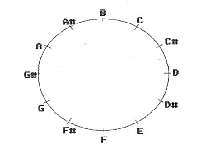
If we draw the triad C-E-G in the module the following
triangle appears:
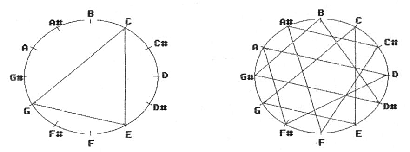
and in the following module we see that this combination of
intervals fits three times in the module: two major triads and
two minor triads. This figure we find on the eleventh hour of
the tone clock. All the other combinations mentioned above,
fit in the module four times except the diminished triad, wich
is displayed as a tetrad, fitting three times in the module.
Combining all the modules with their four complementary
triads on the face of a clock results in the tone clock as
displayed on the first page of this article. The triads of every
hour are steered through the twelve-tone- field by one or
more hours as is shown in the following example.
Harmonies
Due to the fact that every hour contains only its own
intervals, the complementary triads and tetrads sound very
consistant in combination with each other. Every hour
repesents its own colour, and the complete instrument of the
tone clock provides a palet of twelve different harmonic
colours.


Melodies and twelve tone sequenses are very well
supported by these harmonies, and allthough there is no
recognizible tone center, a very transparent opennes can be
derived from this way of composing. An example of this is
the composition "La Riviere Souterraine", which is an
impression on an underground river in France.

It starts of with
a lonely trumpet, reflecting the silence, and grows in volume
and orchestration to an explosion of sound, of which the
echo's repeatedly come back. The echo's slowly die and the
silence returns in the cave. Analysing this composition with
the tone clock, we see in bar 26 a bass figure in E-minor
and the horns play the three complementary chords from
the eleventh hour:

Then a series of eight complementary triads from the
eightth hour follows. In bar 21 till 26 the melody is a twelve
tone sequence, harmonised with tetrads of the seventh
hour. Three of these tetrads are also complemetary and
placed in the module look like this:
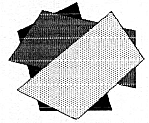
To see by which hour these tetrads are steered, we first
have to put the chords all in the same position.
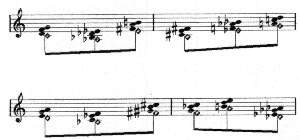
We now see that these tetrads are steered by the twelfth
hour, the open notes demonstrate the movement of the
chords. All of the four triads of the twelfth hour are
represented in this steering. If we look at the first note of
every one of these triads and put them in a sequence we
get the steering on the "second level", which is the steering
of the steering groups. These notes are: C-B-D-F. We saw
earlier that the twelfth hour was only steered by the first
hour. It can however be steered by other hours, but this
allways results in the same four triads. If we change the last
note in this sequence into the closest one, we get C-B-D-Dflat,
wich is the BACH motive transposed with a whole
tone.
In "La Riviere Souterraine" I have chosen for free
improvisation, with this restriction that the musicians get the
instruction to use the composed material as basis for the
improvisation, wich leads to very surprising results,
especially in the pianosolo by Jan Jongbloed on the CD "Ear
Opener". It is also possible to improvise on harmonic
structures, derived from the tone clock. To obtain a jazzy
sound, I like to use tetrads instead of triads, so it is
necessairy to translate the tone clock into jazzharmonies.
To obtain this I developed a system comparible to Ornette
Coleman's Harmolodics. The basic idea behind this is that
three complementary tetrads also create a complete twelve
tone structure. I found a lot of combinations, wich can be
derived from different hours. A few examples:
Derived from the eleventh hour:

Derived from the twelfth hour:

Derived from the sixth hour:

The twelfthhour variation can be heard in the alto solo and
the bass-solo in "2soon2die"; the eleventh hour variation in
the bass-solo on "Onweer", and the C-melody sax solo in
the same composition is based on the sixth hour variation.
Both tunes can be found on the CD "Ear Opener" by the
Theo Hoogstins Octet.
Oda a Walt Whitman
To show how I derive tetrads from the tone clock triads and
how steering on more levels can be achieved, I will show how
I created the harmonic structure of "Ode to Walt Whitman",
based on a poem by Garcia Lorca.

I took triads from the
fourth hour steered by the eighth hour, and distributed the
notes from the third chord over the other three:

These chords I used in the first group of six chords. For the
second group I made another distribution and then changed
the steering:

This gave the following result:
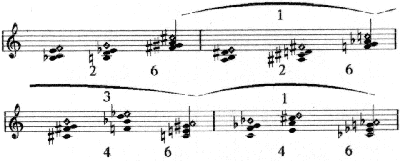
The tetrads ate steered by the eighth hour. On the second
level the groups of three tetrads are steered through the
twelve tone field by the third hour. I continued this steering
for two more groups (1-3-1-3-1) resulting in six groups of three
tetrads.

Now I have two triads of the third hour on the second level.
Then we steer these groups again through the twelve tone
field by the ninth hour, thus adding the six remaining
complementary triads of the third hour to the second level
steering:

The steering on the third level is a symmetrical tetrad of the
seventh hour, so the next step is to steer this tetrad on the
fourth level through the twelve tone field by the twelfth hour.

This results in a harmonic structure of a 108 chords. Now
the composer must go to work to convert this theoretically
built structure into music, because it is always the composer,
and never the method, who makes the music. Elswhere on
this page you can see a part of the result.
I hope it has become clear that the tone clock is merely a
harmony system in the chromatic scale, and not a
composition method, allthough steering on more levels is a
more methodical procedure. The posibilities of it for
composing and analysing are unlimited and more and more
composers find it a useful tool.
Literature:
"The Tone Clock" by Peter Schat.
Contemporary Music Studies: Volume 7
Harwood academic publishers USA.
CD:
"Ear Opener" by the Theo Hoogstins Octet
Disckus Records DC-06.
Back to index page Triosonic













